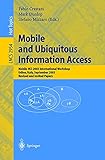Mobile and Ubiquitous Information Access [electronic resource] : Mobile HCI 2003 International Workshop, Udine, Italy, September 8, 2003, Revised and Invited Papers /
Material type: TextSeries: Lecture Notes in Computer Science ; 2954Publisher: Berlin, Heidelberg : Springer Berlin Heidelberg : Imprint: Springer, 2004Edition: 1st ed. 2004Description: X, 306 p. online resourceContent type:
TextSeries: Lecture Notes in Computer Science ; 2954Publisher: Berlin, Heidelberg : Springer Berlin Heidelberg : Imprint: Springer, 2004Edition: 1st ed. 2004Description: X, 306 p. online resourceContent type: - text
- computer
- online resource
- 9783540246411
- User interfaces (Computer systems)
- Human-computer interaction
- Application software
- Computer networks
- Software engineering
- Information storage and retrieval systems
- Microcomputers
- User Interfaces and Human Computer Interaction
- Computer and Information Systems Applications
- Computer Communication Networks
- Software Engineering
- Information Storage and Retrieval
- Personal Computing
- 005.437 23
- 004.019 23
- QA76.9.U83
- QA76.9.H85
Foundations: Concepts, Models, and Paradigms -- The Concept of Relevance in Mobile and Ubiquitous Information Access -- Conversational Design as a Paradigm for User Interaction on Mobile Devices -- One-Handed Use as a Design Driver: Enabling Efficient Multi-channel Delivery of Mobile Applications -- Enabling Communities in Physical and Logical Context Areas as Added Value of Mobile and Ubiquitous Applications -- Interactions -- Accessing Web Educational Resources from Mobile Wireless Devices: The Knowledge Sea Approach -- Spoken versus Written Queries for Mobile Information Access -- Focussed Palmtop Information Access Combining Starfield Displays with Profile-Based Recommendations -- Applications and Experimental Evaluations -- Designing Models and Services for Learning Management Systems in Mobile Settings -- E-Mail on the Move: Categorization, Filtering, and Alerting on Mobile Devices with the ifMail Prototype -- Mobile Access to the Físchlár-News Archive -- A PDA-Based System for Recognizing Buildings from User-Supplied Images -- SmartView and SearchMobil: Providing Overview and Detail in Handheld Browsing -- Compact Summarization for Mobile Phones -- Supporting Searching on Small Screen Devices Using Summarisation -- Towards the Wireless Ward: Evaluating a Trial of Networked PDAs in the National Health Service -- Aspect-Based Adaptation for Ubiquitous Software -- Context and Location -- Context-Aware Retrieval for Ubiquitous Computing Environments -- Ubiquitous Awareness in an Academic Environment -- Accessing Location Data in Mobile Environments – The Nimbus Location Model -- A Localization Service for Mobile Users in Peer-to-Peer Environments -- Sensing and Filtering Surrounding Data: The PERSEND Approach.
The ongoing migration of computing and information access from the desktop and te- phone to mobile computing devices such as PDAs, tablet PCs, and next-generation (3G) phones poses critical challenges for research on information access. Desktop computer users are now used to accessing vast quantities of complex data either directly on their PC or via the Internet – with many services now blurring that distinction. The current state-of-practice of mobile computing devices, be they mobile phones, hand-held computers, or personal digital assistants (PDAs), is very variable. Most mobile phones have no or very limited information storage and very poor Internet access. Furthermore, very few end-users make any, never mind extensive, use of the services that are provided. Hand-held computers, on the other hand, tend to have no wireless network capabilities and tend to be used very much as electronic diaries, with users tending not to go beyond basic diary applications.


There are no comments on this title.